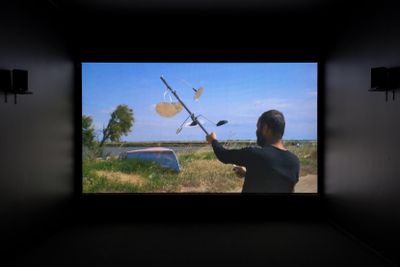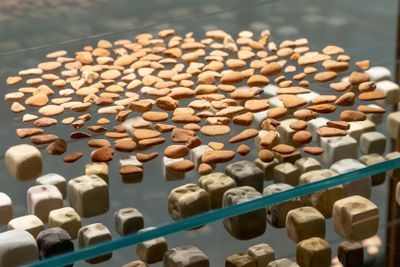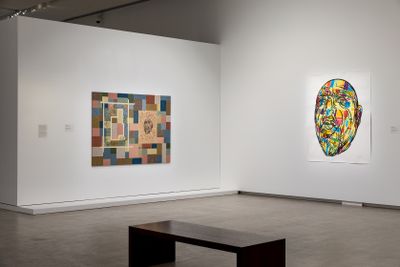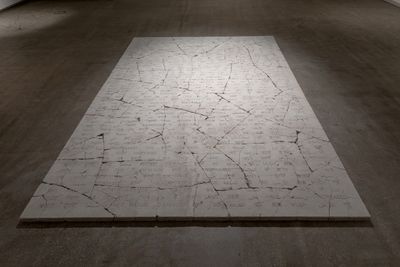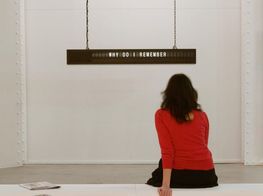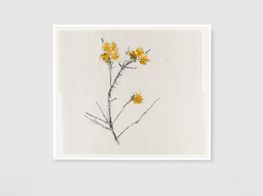TarraWarra International 2019: Tracing Tangible Shadows
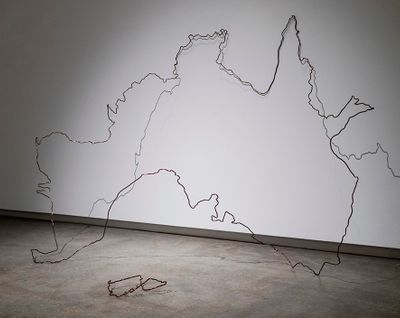
Shilpa Gupta, Map Tracing #7 – AU (2019). Exhibition view: TarraWarra International 2019: The Tangible Trace, TarraWarra Museum of Art, Tarrawarra (8 June–September 2019). Courtesy the artist and Galleria Continua. Photo: Lou Whelan.
Everyone I encounter along my journey asks: 'Where are you based?'
'On my feet,' I answer.
'Where are your feet based then?'
'Feet are never based,' I say.
This haunting voiceover from Hiwa K's video, Pre-Image (Blind as the Mother Tongue) (2017), follows the artist retracing a journey that he made when he was 25 years old, fleeing Iraq and travelling through Iran to Turkey and Greece before eventually finding refuge in Germany. In the film, which is included in TarraWarra International 2019: The Tangible Trace (8 June–1 September 2019), an object-sculpture composed of sticks and motorbike mirrors balances on the artist's nose. Displayed in a separate projection room, the film's central artist-protagonist meanders through foreign territories—from open fields and forests to dense cities and mountainous regions—accompanied by ruminations on departures and arrivals, leaving and loss, wandering and isolation, walking and distance.
At the beginning, the narrator recounts an achingly sad farewell with his mother, concerned that their forced parting might be final: 'Son, if death comes, don't panic. It is just death.' He isn't surprised 'by her relentlessness', he explains—he survived his mother's attempt to abort him three times, after all.
Born in the Iraqi Kurdistan city of Sulaymaniyah in 1975 and currently living in Berlin, Hiwa K was once a realist painter. Now, he apprehends the reality at hand, looking back on his journey and excavating memories of displacement. Recalling the separations, dangers, and risks associated with the plight of refugees, the work's title, Pre-Image (Blind as the Mother Tongue), also includes a clever wordplay on the interrelationship of 'mother' and 'mother tongue'—both signal home, birth, origin, and language.
Hiwa K's solitary and precarious journey is part of a curatorial enterprise that explores the trace in the fourth edition of the TarraWarra International at the TarraWarra Museum of Art, curated by director Victoria Lynn and featuring six artists: Francis Alÿs, Carlos Capelán, Simryn Gill, Shilpa Gupta, Hiwa K, and Sangeeta Sandrasegar. The concept for the exhibition, which considers the notion of the trace as a 'residue or marker of a place, situation or body of knowledge', evolved from a conversation between Lynn and artist Sangeeta Sandrasegar about the metaphor of the shadow. This idea was reaffirmed while Lynn was researching the art of Australian modernist Joy Hester and encountered a phrase from one of her poems: 'the tangible shadow'. In her catalogue essay, Lynn refers to Pliny's classical, 7th-century Greek story of Kora, who traced the outline of her lover—an apprentice of her father's, the potter Dibutades of Sicyon—with coal, which her father filled with clay, creating the first model in relief.
Established in 2013, TarraWarra International places Australian artists alongside their international peers, melding the local and global with new commissions. Earlier editions include Animate/Inanimate (29 June–6 October 2013) that explored climate change and the natural environment; Pierre Huyghe (29 August–22 November 2015), curated with Amelia Barikin about temporality, and All that is solid... (2 September–12 November 2017), investigating the idea of the archival fragment. Each edition has been curated in-house and staged within the TarraWarra Museum of Art's award-winning building (designed by Alan Powell), located in the Yarra Valley region on the outskirts of Melbourne, where the museum, which opened in 2003, was founded by collectors Eva and Marc Besen.
Simryn Gill and Sangeeta Sandrasegar have both appeared in past exhibitions at the Museum, and are thereby familiar inclusions to local audiences here. For this edition, Sandrasegar's new commission, What falls from view (2019), involves covering the windows in the side corridor of the museum, which face out onto a verdant landscape, with layers of fabric. Hand-dyed and overlayed in different colours, these billowing curtains are suggestive of covering while tracing the outline of the window apertures. These five layers of cotton and silk organza conceptually allude to what falls from view and what is absent. Along with a sombre musical score, the subtle installation abstractly traces the migrant and Indigenous past of Tarrawarra, alluding to cover-ups and hidden histories scored into the land.
Gill's Domino Theory (2014) similarly explores a sense of place, with spectres of history, belonging, and displacement conjured in nine vitrines containing a taxonomy of carefully arranged objects and materials from Port Dickson, Malaysia, located in the Strait of Malacca, a busy shipping route, where Gill lives and works. The artist has scoured this location for bricks, tiles, stones, and corals collected from beaches, along with cubes made from termite soil, laid out on glass shelves in incremental rows like archaeological relics of place. First presented at the Espace Louis Vuitton in Munich, Gill arranges and catalogues the objects based on form, material, size, and colour in a systematic array. The title alludes to a term used by the U.S. government during the Cold War, which hypothesised that if one country in Southeast Asia were to adopt Communism, then the surrounding countries would follow in a domino effect.
Uruguay-born and Sweden-based Carlos Capelán presents the most literal depiction of the exhibition thematic with a suite of new paintings of abstract squares overlaid with fragmented faces and outlines of figures displayed in the final gallery space. These quasi-portraits in vivid blues and greens are composed of facial lines that implode across the painted surface, creating both impact and disorientation: 'I am interested in the correlation of both these dynamics (implosion/explosion) as narratives, while making an emphasis on implosion', the artist has stated.
Themes of disintegration and release are evident in Mumbai-based Shilpa Gupta's poetic sculptural invocation The markings we have made on this land have increased the distance so much (2019). This large floor work features the work's title, engraved across its surface in English, Hindi, Arabic, and Chinese. With an associative range that alludes to colonisation, land degradation, fragments, and tombstones, boundaries and interstitial zones are suggested in cracks that appear across the concrete surface. With audiences invited to take a piece of the floor sculpture away, thus dispersing the piece during its presentation, the work transforms as fragments are selected and removed, leaving behind the trace of its original form.
Gupta adeptly unravels the contested narratives of our times in this sculptural rendition, which challenges geographies and borders. As elucidated by Chaitanya Sambrani in his essay 'Shilpa Gupta: Poetry at the Borderlines' for the TarraWarra International 2019 catalogue, 'Gupta's work issues gentle reminders of what fundamentally unites us as humans.'
Currently, Gupta's relevant and resonant work is included in curator, Ralph Rugoff's 58th Venice Biennale, May You Live In Interesting Times (11 May–24 November 2019), with its focus on precarious aspects of existence today. At the main exhibition, Gupta is exhibiting two works, including a mechanical residential gate with exaggerated spikes and a protruding metal frame, swinging and banging menacingly against the gallery wall, causing audible destruction (Untitled, 2009).
In addition, she presents For, in your tongue, I cannot fit – 100 Jailed Poets (2017–2018), an astonishing sonic installation that focuses on the words of 100 poets from around the world who have been jailed or killed for their politics or subversive writings. This moving work was co-commissioned by Yarat Contemporary Art Space and the Edinburgh Art Festival, and was also included in the 9th Asia Pacific Triennial (24 November 2018–28 April 2019) and the 4th Kochi-Muziris Biennale (Possibilities for a Non-Alienated Life, 12 December 2018–29 March 2019). The echoes of voices brought to life by the writings and utterances they left behind, resonates with the notion of the trace in The Tangible Trace.
Francis Alÿs' video Paradox of Praxis 5: Sometimes we dream as we live & sometimes we live as we dream, Ciudad Juárez, Mexico (2013), is an eight-minute film screened in a separate viewing room. Expressing the idea of the trace as a mark of danger and residue, the artist kicks a flaming football around the night-time streets of Ciudad Juárez, Mexico, a city on the border between Mexico and the U.S. that is identified as one of the most dangerous cities in the world. We hear the fireball hissing in the dark as it is kicked through rubble, grimy puddles, and eerie sirens, with the underbelly of the city becoming audible and visible via the amber flames it emits. Under the cover of foreboding darkness, Alÿs' performative action illuminates a passing train, barking wild dogs, emergency vehicles, a fleeting bus, and nocturnal streets.
In an interview in Apollo magazine, Alÿs says of the work: 'It's meant to be a fantasy dream space, where I'm walking with these sights unseen in the background.' At times we see close-ups of cinders as Alÿs moves alone along unsealed paths. His ghostly presence returns us to the sense of isolation and statelessness that Hiwa K's wanderings express in Pre-Image (Blind as the Mother Tongue), bringing into focus the question that this compact, cerebral, and ephemeral exhibition essentially poses: what remains when all seems lost? —[O]

